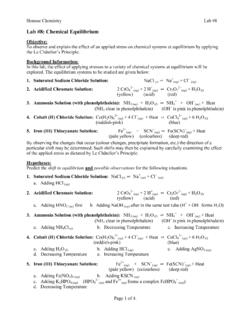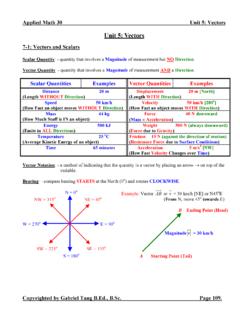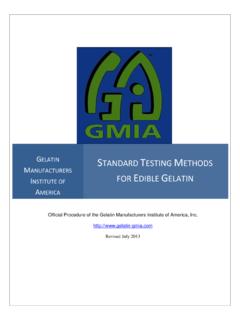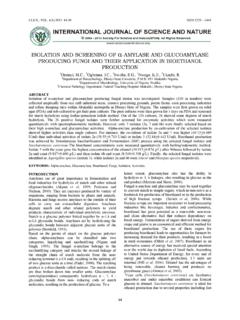Transcription of Lab 13 Qualitative Analysis of Cations and Anions
1 AP Chemistry Lab #13 Page 1 of 8. Lab #13: Qualitative Analysis of Cations and Anions Objectives: 1. To understand the rationale and the procedure behind the separation for various Cations and Anions . 2. To perform Qualitative Analysis of two unknown solutions that contain various ions ( Cations and Anions ) and positively identify these ions using established schemes. Materials: Unknown Cation Solution (may contain some or all of the following) Unknown Anion Solution (may contain some or all of the following) M silver nitrate, AgNO3 (aq) M sodium chloride, NaCl (aq) M copper (II) nitrate, Cu(NO3)2 (aq) M sodium carbonate, Na2CO3 (aq) M zinc nitrate, Zn(NO3)2 (aq) M sodium sulfate, Na2SO4 (aq) M iron (III) nitrate, Fe(NO3)3 (aq) M sodium nitrate, NaNO3 (aq) 6 M HCl (aq) 18 Test Tubes and 4 Test Tube Racks 6 M HNO3 (aq) 400 mL Beaker (Waste) 6 M NH3 (aq) 250 mL Beaker 6 M H2SO4 (aq) Spatula 6 M NaOH (aq) 6 Beral-type Pipets 6 M CH3 COOH (aq) Hot Plate M KSCN (aq) Stirring Rods M potassium ferrocyanide solution, K4Fe(CN)6 (aq)
2 6 Small Test Tube Stoppers M AgNO3 (aq) Litmus or pH Paper Saturated Ba(OH)2 (aq) Watch Glass M BaCl2 (aq) Centrifuge Aluminum granules Background Information: Qualitative Analysis is an analytical procedure in which the question what is present? is answered. In a systematic Qualitative Analysis scheme, each substance present is separated from the other substances. Then a confirmatory test is used to prove that the isolated substance is the expected one. To begin the lab experiment, a solution containing four Cations is analyzed using the techniques for Qualitative Analysis of Cations . A second solution containing four Anions is then analyzed using the Qualitative scheme for Anions .
3 Two solutions, one containing any combination of four different Cations , and another containing any combination of four Anions will be assigned to each student group. The two unknown solutions are then analyzed to determine which ions are present and which are absent. This experiment is carried out on a semi-micro scale. Very small quantities of reagents are used. Cleanliness and a great deal of care are necessary to obtain good results. While going through the steps of the Analysis , keep a copy of the appropriate flow chart available for reference. The flow charts appear on a later page are simplified versions of what you have learned from the textbook. They will help to give the total picture of where each Analysis is and where it is heading.
4 Read the directions carefully, and read the paragraphs that give the notes or chemical theory for each step. Don t just follow directions cook book style, but make an effort to understand the chemical principles behind the procedures. Heating Solutions Frequently it will be necessary to heat a solution to speed up a reaction. Do NOT heat small test tubes over Bunsen burner flames. A sudden steam bubble will cause the solution to shoot out of the test tube. Instead, heat test tubes in a boiling water bath. A good idea is to set up this bath when beginning work in the lab because it may take time to heat the bath to the appropriate temperature. AP Chemistry Lab #13 Page 2 of 8. Stirring Solutions Each time a reagent is added to a test tube, the solution needs to be stirred.
5 It is important to mix the solutions at the top and the bottom of the test tube. A stirring rod that is flattened at the bottom can be used as a plunger to effectively mix solutions in narrow test tubes. Separating Solids from Solutions Centrifuge solutions so that the solid is packed at the bottom of the test tube. Don t forget to counterbalance the test tubes in the centrifuge with similar test tubes holding equivalent volumes of liquid (Figure 1). Let the centrifuge spin for about 30 seconds. Usually the supernatant liquid (the liquid above the precipitate) can be poured off of the precipitate. Sometimes precipitates tend to float on the surface of the solution. If this is the case, use a Beral-type pipet to draw off the supernatant liquid.
6 It is better to leave a little liquid over the precipitate than to transfer some of the precipitate. Washing Precipitates It is almost always necessary to wash precipitates to free them from ions that might cause confusion in later steps. To do this, add 1 or 2 mL of water to the precipitate, stir, centrifuge, and discard the wash water. Sometimes the directions will require a specific reagent in the wash water. Checking the pH To check the pH of a solution, put a piece of litmus paper or pH paper on a clean glass plate or watch glass. Dip the stirring rod into the solution in the test tube, and touch the stirring rod to the paper (see Figure 2). Do NOT dip the test paper into the test tube.
7 This may cause some of the indicator dye to dissolve in the solution, and the indicator colour may confuse subsequent tests. Safety Precautions Silver nitrate solution is mildly toxic and irritating to body tissue. It also stains skin and clothing. Copper (II) nitrate solution is mildly toxic. Zinc nitrate solution is mildly toxic and is irritating to body tissue. Ferric nitrate solution is irritating to body tissue. Barium hydroxide and barium chloride solutions are toxic by ingestion. Potassium thiocyanate solution is slightly toxic by ingestion. Avoid contact with concentrated acids since toxic hydrogen cyanide gas may be liberated. Concentrated ammonia (ammonium hydroxide) solution and hydrochloric acid solutions are toxic by inhalation, ingestion, and are corrosive to all body tissues.
8 Sulfuric acid solution and sodium hydroxide solution are severely corrosive to eyes, skin, and other tissue. Nitric acid solution is severely corrosive, a strong oxidant, and toxic by ingestion and inhalation. Acetic acid solution is a corrosive liquid. Wear chemical splash goggles, and a chemical-resistant apron. Wash hands thoroughly with soap and water before leaving the laboratory. Never fill centrifuge tubes to capacity. Keep liquid levels at least 1 cm from the top. Label all centrifuge tubes before inserting to avoid mix-up. Place tubes in a symmetrical fashion, the objective being to keep the rotor balanced. Fill all tubes to the same height. Follow manufacturer s directions.
9 If only one tube needs to be centrifuged, achieve balance by inserting an additional tube (labeled as a blank ) containing the same volume of liquid. Figure 1. How to safely load and use a centrifuge. AP Chemistry Lab #13 Page 3 of 8. AP Chemistry Lab #13 Page 4 of 8. Pre-Lab Questions Use the flow charts on the previous page to answer the following questions. In each question, a test is carried out to determine the presence or absence of several ions. Only those listed may be present. State if the tests indicate if each ion is present, absent, or undetermined. 1. Test for Ag+, Cu2+, Fe3+ Some 6 M HCl is added to a solution that may contain the three ions.
10 A white precipitate forms. Ions present: _____ Ions absent: _____ Ions undetermined: _____ 2. Test for Cu2+, Ag+, and Zn2+ Some 6 M HCl is added to a solution that may contain the three ions. No precipitate forms. The addition of 6 M NaOH until the solution is basic results in no formation of precipitate. Ions present: _____ Ions absent: _____ Ions undetermined: _____ 3. Test for Cu2+, Fe3+, and Zn2+ 6 M NaOH is added to a clear solution that may contain the three ions until the solution is basic. A dark precipitate forms. The precipitate totally dissolves in 6 M H2SO4. The addition of 6 M NH3 to this acidic solution until it is basic results in a clear solution containing a dark precipitate.














